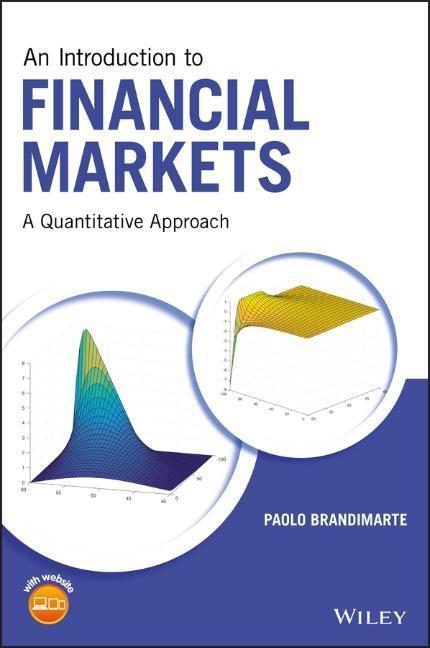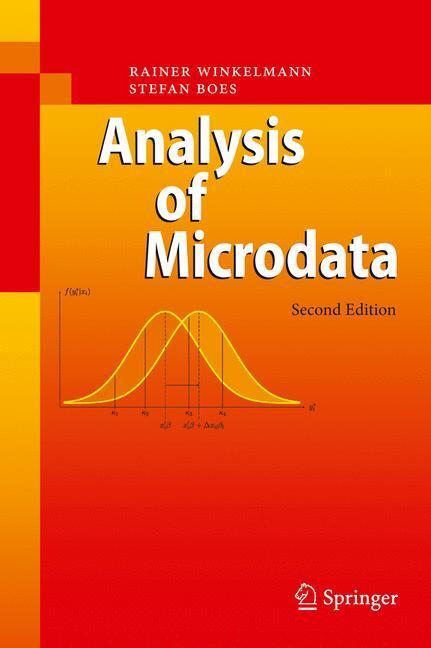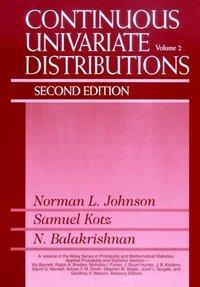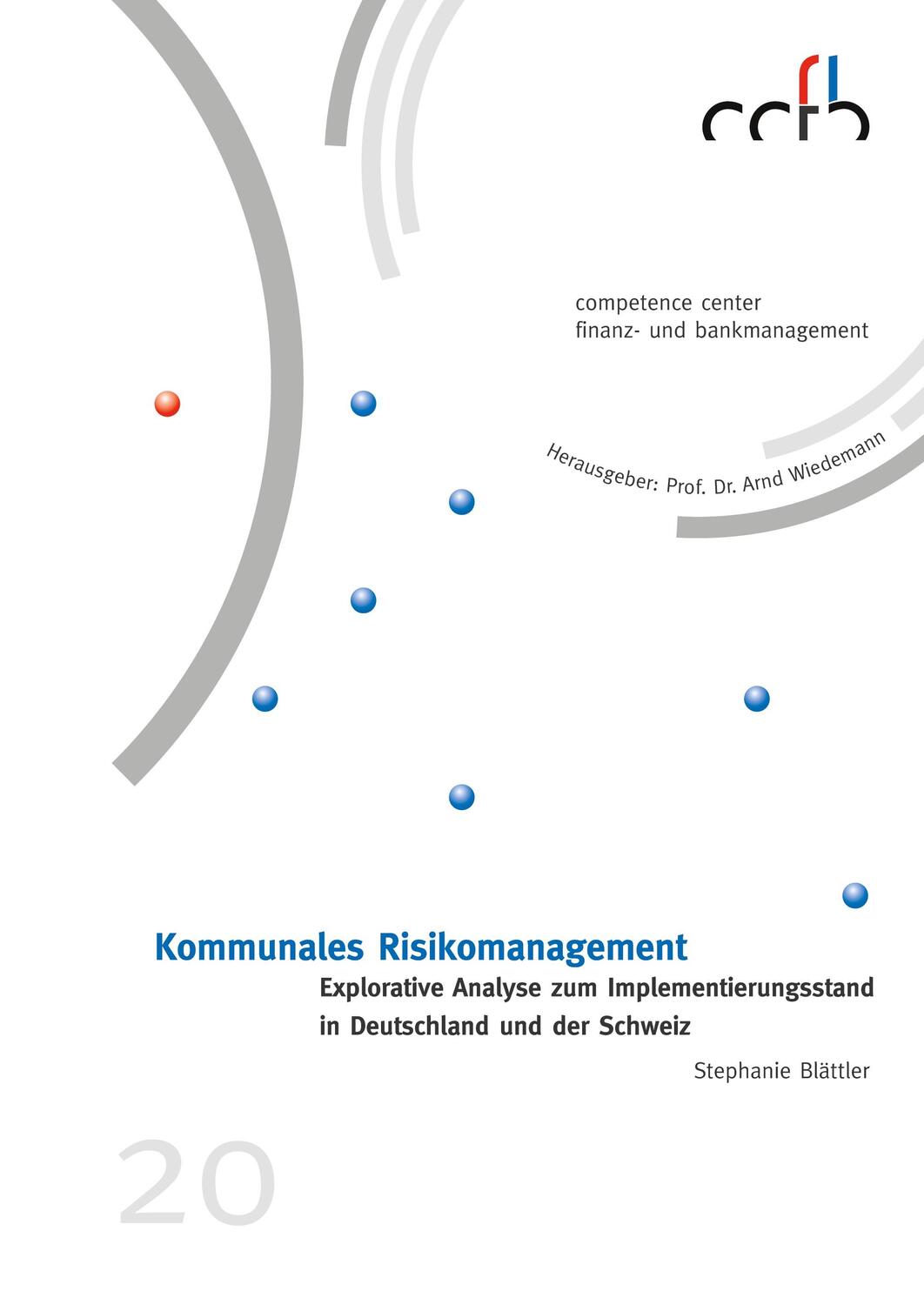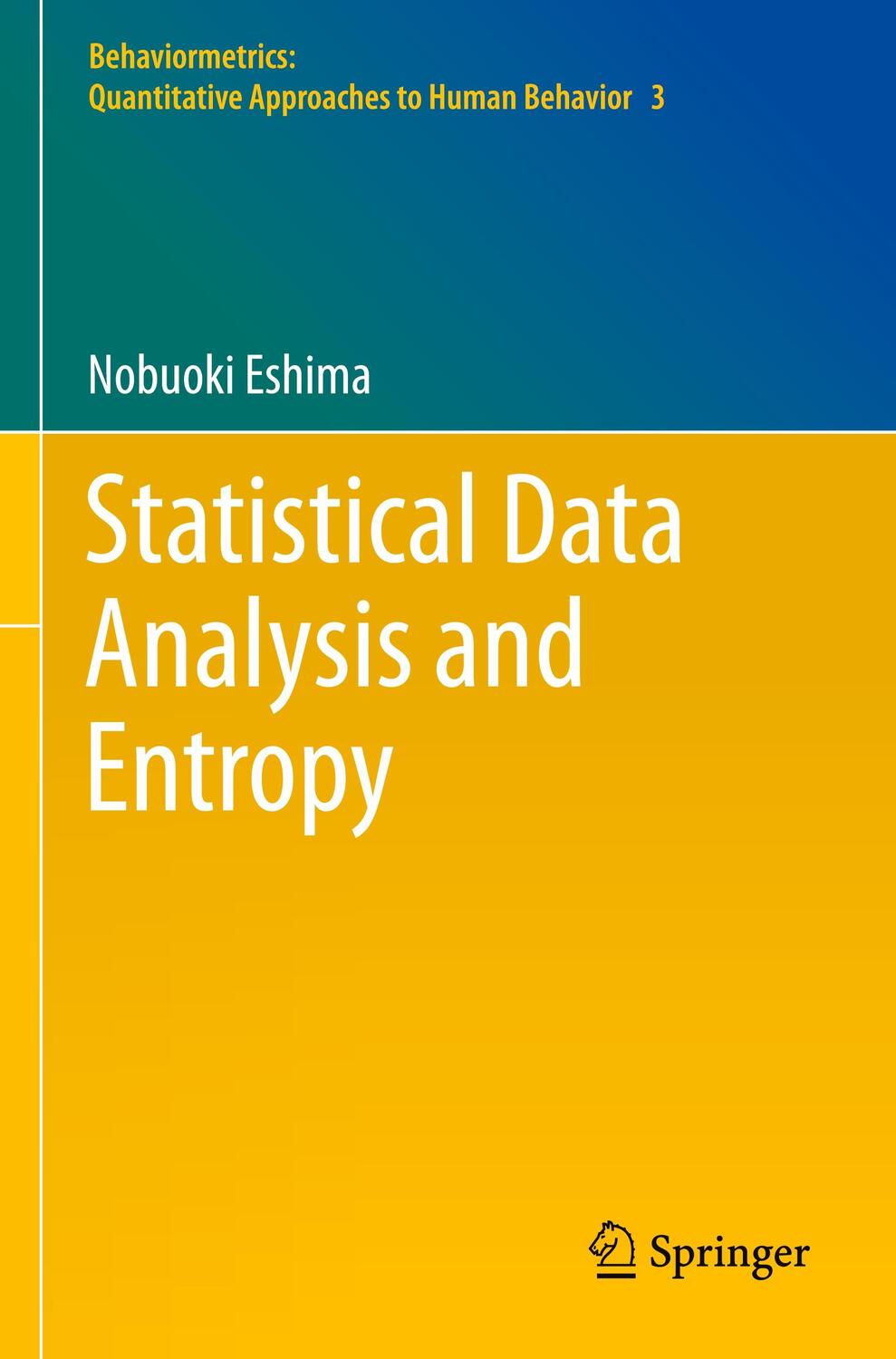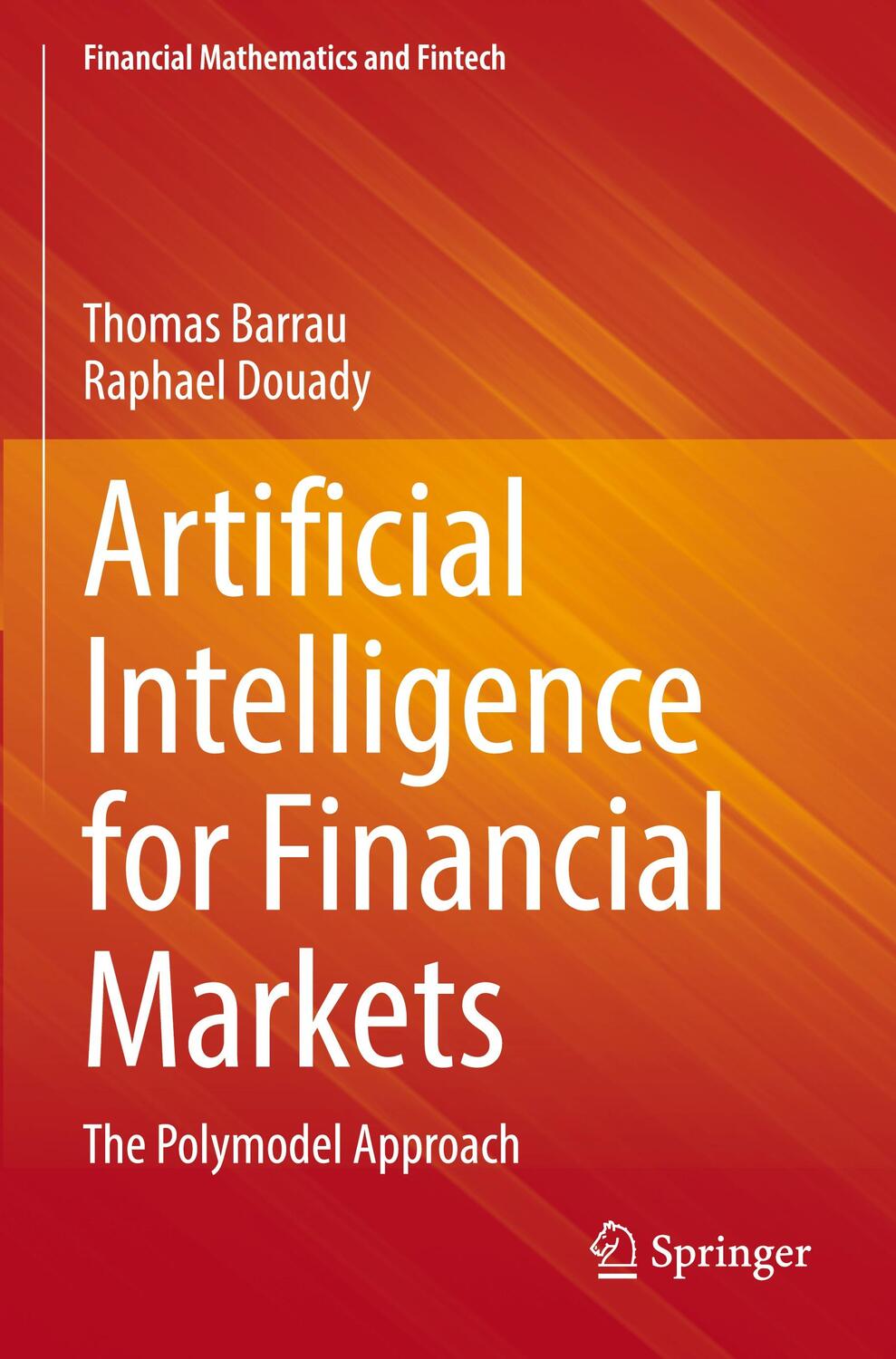147,50 €*
Versandkostenfrei per Post / DHL
Aktuell nicht verfügbar
This comprehensive yet accessible book introduces students to financial markets and delves into more advanced material at a steady pace while providing motivating examples, poignant remarks, counterexamples, ideological clashes, and intuitive traps throughout. Tempered by real-life cases and actual market structures, An Introduction to Financial Markets: A Quantitative Approach accentuates theory through quantitative modeling whenever and wherever necessary. It focuses on the lessons learned from timely subject matter such as the impact of the recent subprime mortgage storm, the collapse of LTCM, and the harsh criticism on risk management and innovative finance. The book also provides the necessary foundations in stochastic calculus and optimization, alongside financial modeling concepts that are illustrated with relevant and hands-on examples.
An Introduction to Financial Markets: A Quantitative Approach starts with a complete overview of the subject matter. It then moves on to sections covering fixed income assets, equity portfolios, derivatives, and advanced optimization models. This book's balanced and broad view of the state-of-the-art in financial decision-making helps provide readers with all the background and modeling tools needed to make "honest money" and, in the process, to become a sound professional.
* Stresses that gut feelings are not always sufficient and that "critical thinking" and real world applications are appropriate when dealing with complex social systems involving multiple players with conflicting incentives
* Features a related website that contains a solution manual for end-of-chapter problems
* Written in a modular style for tailored classroom use
* Bridges a gap for business and engineering students who are familiar with the problems involved, but are less familiar with the methodologies needed to make smart decisions
An Introduction to Financial Markets: A Quantitative Approach offers a balance between the need to illustrate mathematics in action and the need to understand the real life context. It is an ideal text for a first course in financial markets or investments for business, economic, statistics, engineering, decision science, and management science students.
This comprehensive yet accessible book introduces students to financial markets and delves into more advanced material at a steady pace while providing motivating examples, poignant remarks, counterexamples, ideological clashes, and intuitive traps throughout. Tempered by real-life cases and actual market structures, An Introduction to Financial Markets: A Quantitative Approach accentuates theory through quantitative modeling whenever and wherever necessary. It focuses on the lessons learned from timely subject matter such as the impact of the recent subprime mortgage storm, the collapse of LTCM, and the harsh criticism on risk management and innovative finance. The book also provides the necessary foundations in stochastic calculus and optimization, alongside financial modeling concepts that are illustrated with relevant and hands-on examples.
An Introduction to Financial Markets: A Quantitative Approach starts with a complete overview of the subject matter. It then moves on to sections covering fixed income assets, equity portfolios, derivatives, and advanced optimization models. This book's balanced and broad view of the state-of-the-art in financial decision-making helps provide readers with all the background and modeling tools needed to make "honest money" and, in the process, to become a sound professional.
* Stresses that gut feelings are not always sufficient and that "critical thinking" and real world applications are appropriate when dealing with complex social systems involving multiple players with conflicting incentives
* Features a related website that contains a solution manual for end-of-chapter problems
* Written in a modular style for tailored classroom use
* Bridges a gap for business and engineering students who are familiar with the problems involved, but are less familiar with the methodologies needed to make smart decisions
An Introduction to Financial Markets: A Quantitative Approach offers a balance between the need to illustrate mathematics in action and the need to understand the real life context. It is an ideal text for a first course in financial markets or investments for business, economic, statistics, engineering, decision science, and management science students.
PAOLO BRANDIMARTE is Full Professor at the Department of Mathematical Sciences of Politecnico di Torino in Italy, where he teaches Business Analytics and Financial Engineering. He is the author of several publications, including more than ten books on the application of optimization and simulation to diverse areas such as production and supply chain management, telecommunications, and finance.
About the Companion Website xix
Part I Overview
1 Financial Markets: Functions, Institutions, and Traded Assets 1
1.1 What is the purpose of finance? 2
1.2 Traded assets 12
1.2.1 The balance sheet 15
1.2.2 Assets vs. securities 20
1.2.3 Equity 22
1.2.4 Fixed income 24
1.2.5 FOREX markets 27
1.2.6 Derivatives 29
1.3 Market participants and their roles 46
1.3.1 Commercial vs. investment banks 48
1.3.2 Investment funds and insurance companies 49
1.3.3 Dealers and brokers 51
1.3.4 Hedgers, speculators, and arbitrageurs 51
1.4 Market structure and trading strategies 53
1.4.1 Primary and secondary markets 53
1.4.2 Over-the-counter vs. exchange-traded derivatives 53
1.4.3 Auction mechanisms and the limit order book 53
1.4.4 Buying on margin and leverage 55
1.4.5 Short-selling 58
1.5 Market indexes 60
Problems 63
Further reading 65
Bibliography 65
2 Basic Problems in Quantitative Finance 67
2.1 Portfolio optimization 68
2.1.1 Static portfolio optimization: Mean-variance efficiency 70
2.1.2 Dynamic decision-making under uncertainty: A stylized consumption-saving model 75
2.2 Risk measurement and management 80
2.2.1 Sensitivity of asset prices to underlying risk factors 81
2.2.2 Risk measures in a non-normal world: Value-atrisk 84
2.2.3 Risk management: Introductory hedging examples 93
2.2.4 Financial vs. nonfinancial risk factors 100
2.3 The no-arbitrage principle in asset pricing 102
2.3.1 Why do we need asset pricing models? 103
2.3.2 Arbitrage strategies 104
2.3.3 Pricing by no-arbitrage 108
2.3.4 Option pricing in a binomial model 112
2.3.5 The limitations of the no-arbitrage principle 116
2.4 The mathematics of arbitrage 117
2.4.1 Linearity of the pricing functional and law of one price 119
2.4.2 Dominant strategies 120
2.4.3 No-arbitrage principle and risk-neutral measures 125
S2.1 Multiobjective optimization 129
S2.2 Summary of LP duality 133
Problems 137
Further reading 139
Bibliography 139
Part II Fixed income assets
3 Elementary Theory of Interest Rates 143
3.1 The time value of money: Shifting money forward in time 146
3.1.1 Simple vs. compounded rates 147
3.1.2 Quoted vs. effective rates: Compounding frequencies 150
3.2 The time value of money: Shifting money backward in time 153
3.2.1 Discount factors and pricing a zero-coupon bond 154
3.2.2 Discount factors vs. interest rates 158
3.3 Nominal vs. real interest rates 161
3.4 The term structure of interest rates 163
3.5 Elementary bond pricing 165
3.5.1 Pricing coupon-bearing bonds 165
3.5.2 From bond prices to term structures, and vice versa 168
3.5.3 What is a risk-free rate, anyway? 171
3.5.4 Yield-to-maturity 174
3.5.5 Interest rate risk 180
3.5.6 Pricing floating rate bonds 188
3.6 A digression: Elementary investment analysis 190
3.6.1 Net present value 191
3.6.2 Internal rate of return 192
3.6.3 Real options 193
3.7 Spot vs. forward interest rates 193
3.7.1 The forward and the spot rate curves 197
3.7.2 Discretely compounded forward rates 197
3.7.3 Forward discount factors 198
3.7.4 The expectation hypothesis 199
3.7.5 A word of caution: Model risk and hidden assumptions 202
S3.1 Proof of Equation (3.42) 203 Problems 203
Further reading 205
Bibliography 205
4 Forward Rate Agreements, Interest Rate Futures, and Vanilla Swaps 207
4.1 LIBOR and EURIBOR rates 208
4.2 Forward rate agreements 209
4.2.1 A hedging view of forward rates 210
4.2.2 FRAs as bond trades 214
4.2.3 A numerical example 215
[...]odollar futures 216
4.4 Vanilla interest rate swaps 220
4.4.1 Swap valuation: Approach 1 221
4.4.2 Swap valuation: Approach 2 223
4.4.3 The swap curve and the term structure 225
Problems 226
Further reading 226
Bibliography 226
5 Fixed-Income Markets 229
5.1 Day count conventions 230
5.2 Bond markets 231
5.2.1 Bond credit ratings 233
5.2.2 Quoting bond prices 233
5.2.3 Bonds with embedded options 235
5.3 Interest rate derivatives 237
5.3.1 Swap markets 237
5.3.2 Bond futures and options 238
5.4 The repo market and other money market instruments 239
5.5 Securitization 240
Problems 244
Further reading 244
Bibliography 244
6 Interest Rate Risk Management 247
6.1 Duration as a first-order sensitivity measure 248
6.1.1 Duration of fixed-coupon bonds 250
6.1.2 Duration of a floater 254
6.1.3 Dollar duration and interest rate swaps 255
6.2 Further interpretations of duration 257
6.2.1 Duration and investment horizons 258
6.2.2 Duration and yield volatility 260
6.2.3 Duration and quantile-based risk measures 260
6.3 Classical duration-based immunization 261
6.3.1 Cash flow matching 262
6.3.2 Duration matching 263
6.4 Immunization by interest rate derivatives 265
6.4.1 Using interest rate swaps in asset-liability management 266
6.5 A second-order refinement: Convexity 266
6.6 Multifactor models in interest rate risk management 269
Problems 271
Further reading 272
Bibliography 273
Part III Equity portfolios
7 Decision-Making under Uncertainty: The Static Case 277
7.1 Introductory examples 278
7.2 Should we just consider expected values of returns and monetary outcomes? 282
7.2.1 Formalizing static decision-making under uncertainty 283
7.2.2 The flaw of averages 284
7.3 A conceptual tool: The utility function 288
7.3.1 A few standard utility functions 293
7.3.2 Limitations of utility functions 297
7.4 Mean-risk models 299
7.4.1 Coherent risk measures 300
7.4.2 Standard deviation and variance as risk measures 302
7.4.3 Quantile-based risk measures: V@R and CV@R 303
7.4.4 Formulation of mean-risk models 309
7.5 Stochastic dominance 310
S7.1 Theorem proofs 314
S7.1.1 Proof of Theorem 7.2 314
S7.1.2 Proof of Theorem 7.4 315
Problems 315
Further reading 317
Bibliography 317
8 Mean-Variance Efficient Portfolios 319
8.1 Risk aversion and capital allocation to risky assets 320
8.1.1 The role of risk aversion 324
8.2 The mean-variance efficient frontier with risky assets 325
8.2.1 Diversification and portfolio risk 325
8.2.2 The efficient frontier in the case of two risky assets 326
8.2.3 The efficient frontier in the case of n risky assets 329
8.3 Mean-variance efficiency with a risk-free asset: The separation property 332
8.4 Maximizing the Sharpe ratio 337
8.4.1 Technical issues in Sharpe ratio maximization 340
8.5 Mean-variance efficiency vs. expected utility 341
8.6 Instability in mean-variance portfolio optimization 343
S8.1 The attainable set for two risky assets is a hyperbola 345
S8.2 Explicit solution of mean-variance optimization in matrix form 346
Problems 348
Further reading 349
Bibliography 349
9 Factor Models 351
9.1 Statistical issues in mean-variance portfolio optimization 352
9.2 The single-index model 353
9.2.1 Estimating a factor model 354
9.2.2 Portfolio optimization within the single-index model 356
9.3 The Treynor-Black model 358
9.3.1 A top-down/bottom-up optimization procedure 362
9.4 Multifactor models 365
9.5 Factor models in practice 367
S9.1 Proof of Equation (9.17) 368
Problems 369
Further reading 371
Bibliography 371
10 Equilibrium Models: CAPM and APT 373
10.1 What is an equilibrium model? 374
10.2 The capital asset pricing model 375
10.2.1 Proof of the CAPM formula 377
10.2.2 Interpreting CAPM 378
10.2.3 CAPM as a pricing formula and its practical relevance 380
10.3 The Black-Litterman portfolio optimization model 381
10.3.1 Black-Litterman model: The role of CAPM and Bayesian Statistics 382
10.3.2 Black-Litterman model: A numerical example 386
10.4 Arbitrage pricing theory 388
10.4.1 The intuition 389
10.4.2 A not-so-rigorous proof of APT 391
10.4.3 APT for Well-Diversified Portfolios 392
10.4.4 APT for Individual Assets 393
10.4.5 Interpreting and using APT 394
10.5 The behavioral critique 398
10.5.1 The efficient market hypothesis 400
10.5.2 The psychology of choice by agents with limited rationality 400
10.5.3 Prospect theory: The aversion to sure loss 401
S10.1Bayesian statistics 404
S10.1.1 Bayesian estimation 405
S10.1.2 Bayesian learning in coin flipping 407
S10.1.3 The expected value of a normal distribution 408
Problems 411
Further reading 413
Bibliography 413
Part IV Derivatives
11 Modeling Dynamic Uncertainty 417
11.1 Stochastic processes 420
11.1.1 Introductory examples 422
11.1.2 Marginals do not tell the whole story 428
11.1.3 Modeling information: Filtration generated by a stochastic process 430
11.1.4 Markov processes 433
11.1.5 Martingales 436
11.2 Stochastic processes in continuous time 438
11.2.1 A fundamental building block: Standard Wiener process 438
11.2.2 A generalization: Lévy processes 440
11.3 Stochastic differential equations 441
11.3.1 A deterministic differential equation: The bank account process 442
11.3.2 The generalized Wiener process 443
11.3.3 Geometric Brownian motion and Itô processes 445
11.4 Stochastic integration and Itô's lemma 447
11.4.1 A digression: Riemann and Riemann-Stieltjes integrals 447
11.4.2 Stochastic integral in the sense of Itô 448
11.4.3 Itô's lemma 453
11.5 Stochastic processes in financial modeling 457
11.5.1 Geometric Brownian motion 457
11.5.2 Generalizations 460
11.6 Sample path generation 462
11.6.1 Monte Carlo sampling 463
11.6.2 Scenario trees 465
S11.1Probability spaces, measurability, and information 468
Problems 476
Further reading 478
Bibliography 478
12 Forward and Futures Contracts 481
12.1 Pricing forward contracts on equity and foreign currencies 482
12.1.1 The spot-forward parity theorem 482
12.1.2 The spot-forward parity theorem with dividend income 485
12.1.3 Forward contracts on currencies 487
12.1.4 Forward contracts on commodities or energy: Contango and backwardation 489
12.2 Forward vs. futures contracts 490
12.3 Hedging with linear contracts 493
12.3.1 Quantity-based hedging 493
12.3.2 Basis risk and minimum variance hedging 494
12.3.3 Hedging with index futures 496
12.3.4 Tailing the hedge 499
Problems...
| Erscheinungsjahr: | 2017 |
|---|---|
| Fachbereich: | Betriebswirtschaft |
| Genre: | Wirtschaft |
| Rubrik: | Recht & Wirtschaft |
| Medium: | Buch |
| Seiten: | 784 |
| Inhalt: | 784 S. |
| ISBN-13: | 9781118014776 |
| ISBN-10: | 1118014774 |
| Sprache: | Englisch |
| Einband: | Gebunden |
| Autor: | Brandimarte, Paolo |
| Hersteller: |
Wiley
John Wiley & Sons |
| Maße: | 261 x 182 x 48 mm |
| Von/Mit: | Paolo Brandimarte |
| Erscheinungsdatum: | 13.11.2017 |
| Gewicht: | 1,519 kg |
PAOLO BRANDIMARTE is Full Professor at the Department of Mathematical Sciences of Politecnico di Torino in Italy, where he teaches Business Analytics and Financial Engineering. He is the author of several publications, including more than ten books on the application of optimization and simulation to diverse areas such as production and supply chain management, telecommunications, and finance.
About the Companion Website xix
Part I Overview
1 Financial Markets: Functions, Institutions, and Traded Assets 1
1.1 What is the purpose of finance? 2
1.2 Traded assets 12
1.2.1 The balance sheet 15
1.2.2 Assets vs. securities 20
1.2.3 Equity 22
1.2.4 Fixed income 24
1.2.5 FOREX markets 27
1.2.6 Derivatives 29
1.3 Market participants and their roles 46
1.3.1 Commercial vs. investment banks 48
1.3.2 Investment funds and insurance companies 49
1.3.3 Dealers and brokers 51
1.3.4 Hedgers, speculators, and arbitrageurs 51
1.4 Market structure and trading strategies 53
1.4.1 Primary and secondary markets 53
1.4.2 Over-the-counter vs. exchange-traded derivatives 53
1.4.3 Auction mechanisms and the limit order book 53
1.4.4 Buying on margin and leverage 55
1.4.5 Short-selling 58
1.5 Market indexes 60
Problems 63
Further reading 65
Bibliography 65
2 Basic Problems in Quantitative Finance 67
2.1 Portfolio optimization 68
2.1.1 Static portfolio optimization: Mean-variance efficiency 70
2.1.2 Dynamic decision-making under uncertainty: A stylized consumption-saving model 75
2.2 Risk measurement and management 80
2.2.1 Sensitivity of asset prices to underlying risk factors 81
2.2.2 Risk measures in a non-normal world: Value-atrisk 84
2.2.3 Risk management: Introductory hedging examples 93
2.2.4 Financial vs. nonfinancial risk factors 100
2.3 The no-arbitrage principle in asset pricing 102
2.3.1 Why do we need asset pricing models? 103
2.3.2 Arbitrage strategies 104
2.3.3 Pricing by no-arbitrage 108
2.3.4 Option pricing in a binomial model 112
2.3.5 The limitations of the no-arbitrage principle 116
2.4 The mathematics of arbitrage 117
2.4.1 Linearity of the pricing functional and law of one price 119
2.4.2 Dominant strategies 120
2.4.3 No-arbitrage principle and risk-neutral measures 125
S2.1 Multiobjective optimization 129
S2.2 Summary of LP duality 133
Problems 137
Further reading 139
Bibliography 139
Part II Fixed income assets
3 Elementary Theory of Interest Rates 143
3.1 The time value of money: Shifting money forward in time 146
3.1.1 Simple vs. compounded rates 147
3.1.2 Quoted vs. effective rates: Compounding frequencies 150
3.2 The time value of money: Shifting money backward in time 153
3.2.1 Discount factors and pricing a zero-coupon bond 154
3.2.2 Discount factors vs. interest rates 158
3.3 Nominal vs. real interest rates 161
3.4 The term structure of interest rates 163
3.5 Elementary bond pricing 165
3.5.1 Pricing coupon-bearing bonds 165
3.5.2 From bond prices to term structures, and vice versa 168
3.5.3 What is a risk-free rate, anyway? 171
3.5.4 Yield-to-maturity 174
3.5.5 Interest rate risk 180
3.5.6 Pricing floating rate bonds 188
3.6 A digression: Elementary investment analysis 190
3.6.1 Net present value 191
3.6.2 Internal rate of return 192
3.6.3 Real options 193
3.7 Spot vs. forward interest rates 193
3.7.1 The forward and the spot rate curves 197
3.7.2 Discretely compounded forward rates 197
3.7.3 Forward discount factors 198
3.7.4 The expectation hypothesis 199
3.7.5 A word of caution: Model risk and hidden assumptions 202
S3.1 Proof of Equation (3.42) 203 Problems 203
Further reading 205
Bibliography 205
4 Forward Rate Agreements, Interest Rate Futures, and Vanilla Swaps 207
4.1 LIBOR and EURIBOR rates 208
4.2 Forward rate agreements 209
4.2.1 A hedging view of forward rates 210
4.2.2 FRAs as bond trades 214
4.2.3 A numerical example 215
[...]odollar futures 216
4.4 Vanilla interest rate swaps 220
4.4.1 Swap valuation: Approach 1 221
4.4.2 Swap valuation: Approach 2 223
4.4.3 The swap curve and the term structure 225
Problems 226
Further reading 226
Bibliography 226
5 Fixed-Income Markets 229
5.1 Day count conventions 230
5.2 Bond markets 231
5.2.1 Bond credit ratings 233
5.2.2 Quoting bond prices 233
5.2.3 Bonds with embedded options 235
5.3 Interest rate derivatives 237
5.3.1 Swap markets 237
5.3.2 Bond futures and options 238
5.4 The repo market and other money market instruments 239
5.5 Securitization 240
Problems 244
Further reading 244
Bibliography 244
6 Interest Rate Risk Management 247
6.1 Duration as a first-order sensitivity measure 248
6.1.1 Duration of fixed-coupon bonds 250
6.1.2 Duration of a floater 254
6.1.3 Dollar duration and interest rate swaps 255
6.2 Further interpretations of duration 257
6.2.1 Duration and investment horizons 258
6.2.2 Duration and yield volatility 260
6.2.3 Duration and quantile-based risk measures 260
6.3 Classical duration-based immunization 261
6.3.1 Cash flow matching 262
6.3.2 Duration matching 263
6.4 Immunization by interest rate derivatives 265
6.4.1 Using interest rate swaps in asset-liability management 266
6.5 A second-order refinement: Convexity 266
6.6 Multifactor models in interest rate risk management 269
Problems 271
Further reading 272
Bibliography 273
Part III Equity portfolios
7 Decision-Making under Uncertainty: The Static Case 277
7.1 Introductory examples 278
7.2 Should we just consider expected values of returns and monetary outcomes? 282
7.2.1 Formalizing static decision-making under uncertainty 283
7.2.2 The flaw of averages 284
7.3 A conceptual tool: The utility function 288
7.3.1 A few standard utility functions 293
7.3.2 Limitations of utility functions 297
7.4 Mean-risk models 299
7.4.1 Coherent risk measures 300
7.4.2 Standard deviation and variance as risk measures 302
7.4.3 Quantile-based risk measures: V@R and CV@R 303
7.4.4 Formulation of mean-risk models 309
7.5 Stochastic dominance 310
S7.1 Theorem proofs 314
S7.1.1 Proof of Theorem 7.2 314
S7.1.2 Proof of Theorem 7.4 315
Problems 315
Further reading 317
Bibliography 317
8 Mean-Variance Efficient Portfolios 319
8.1 Risk aversion and capital allocation to risky assets 320
8.1.1 The role of risk aversion 324
8.2 The mean-variance efficient frontier with risky assets 325
8.2.1 Diversification and portfolio risk 325
8.2.2 The efficient frontier in the case of two risky assets 326
8.2.3 The efficient frontier in the case of n risky assets 329
8.3 Mean-variance efficiency with a risk-free asset: The separation property 332
8.4 Maximizing the Sharpe ratio 337
8.4.1 Technical issues in Sharpe ratio maximization 340
8.5 Mean-variance efficiency vs. expected utility 341
8.6 Instability in mean-variance portfolio optimization 343
S8.1 The attainable set for two risky assets is a hyperbola 345
S8.2 Explicit solution of mean-variance optimization in matrix form 346
Problems 348
Further reading 349
Bibliography 349
9 Factor Models 351
9.1 Statistical issues in mean-variance portfolio optimization 352
9.2 The single-index model 353
9.2.1 Estimating a factor model 354
9.2.2 Portfolio optimization within the single-index model 356
9.3 The Treynor-Black model 358
9.3.1 A top-down/bottom-up optimization procedure 362
9.4 Multifactor models 365
9.5 Factor models in practice 367
S9.1 Proof of Equation (9.17) 368
Problems 369
Further reading 371
Bibliography 371
10 Equilibrium Models: CAPM and APT 373
10.1 What is an equilibrium model? 374
10.2 The capital asset pricing model 375
10.2.1 Proof of the CAPM formula 377
10.2.2 Interpreting CAPM 378
10.2.3 CAPM as a pricing formula and its practical relevance 380
10.3 The Black-Litterman portfolio optimization model 381
10.3.1 Black-Litterman model: The role of CAPM and Bayesian Statistics 382
10.3.2 Black-Litterman model: A numerical example 386
10.4 Arbitrage pricing theory 388
10.4.1 The intuition 389
10.4.2 A not-so-rigorous proof of APT 391
10.4.3 APT for Well-Diversified Portfolios 392
10.4.4 APT for Individual Assets 393
10.4.5 Interpreting and using APT 394
10.5 The behavioral critique 398
10.5.1 The efficient market hypothesis 400
10.5.2 The psychology of choice by agents with limited rationality 400
10.5.3 Prospect theory: The aversion to sure loss 401
S10.1Bayesian statistics 404
S10.1.1 Bayesian estimation 405
S10.1.2 Bayesian learning in coin flipping 407
S10.1.3 The expected value of a normal distribution 408
Problems 411
Further reading 413
Bibliography 413
Part IV Derivatives
11 Modeling Dynamic Uncertainty 417
11.1 Stochastic processes 420
11.1.1 Introductory examples 422
11.1.2 Marginals do not tell the whole story 428
11.1.3 Modeling information: Filtration generated by a stochastic process 430
11.1.4 Markov processes 433
11.1.5 Martingales 436
11.2 Stochastic processes in continuous time 438
11.2.1 A fundamental building block: Standard Wiener process 438
11.2.2 A generalization: Lévy processes 440
11.3 Stochastic differential equations 441
11.3.1 A deterministic differential equation: The bank account process 442
11.3.2 The generalized Wiener process 443
11.3.3 Geometric Brownian motion and Itô processes 445
11.4 Stochastic integration and Itô's lemma 447
11.4.1 A digression: Riemann and Riemann-Stieltjes integrals 447
11.4.2 Stochastic integral in the sense of Itô 448
11.4.3 Itô's lemma 453
11.5 Stochastic processes in financial modeling 457
11.5.1 Geometric Brownian motion 457
11.5.2 Generalizations 460
11.6 Sample path generation 462
11.6.1 Monte Carlo sampling 463
11.6.2 Scenario trees 465
S11.1Probability spaces, measurability, and information 468
Problems 476
Further reading 478
Bibliography 478
12 Forward and Futures Contracts 481
12.1 Pricing forward contracts on equity and foreign currencies 482
12.1.1 The spot-forward parity theorem 482
12.1.2 The spot-forward parity theorem with dividend income 485
12.1.3 Forward contracts on currencies 487
12.1.4 Forward contracts on commodities or energy: Contango and backwardation 489
12.2 Forward vs. futures contracts 490
12.3 Hedging with linear contracts 493
12.3.1 Quantity-based hedging 493
12.3.2 Basis risk and minimum variance hedging 494
12.3.3 Hedging with index futures 496
12.3.4 Tailing the hedge 499
Problems...
| Erscheinungsjahr: | 2017 |
|---|---|
| Fachbereich: | Betriebswirtschaft |
| Genre: | Wirtschaft |
| Rubrik: | Recht & Wirtschaft |
| Medium: | Buch |
| Seiten: | 784 |
| Inhalt: | 784 S. |
| ISBN-13: | 9781118014776 |
| ISBN-10: | 1118014774 |
| Sprache: | Englisch |
| Einband: | Gebunden |
| Autor: | Brandimarte, Paolo |
| Hersteller: |
Wiley
John Wiley & Sons |
| Maße: | 261 x 182 x 48 mm |
| Von/Mit: | Paolo Brandimarte |
| Erscheinungsdatum: | 13.11.2017 |
| Gewicht: | 1,519 kg |

